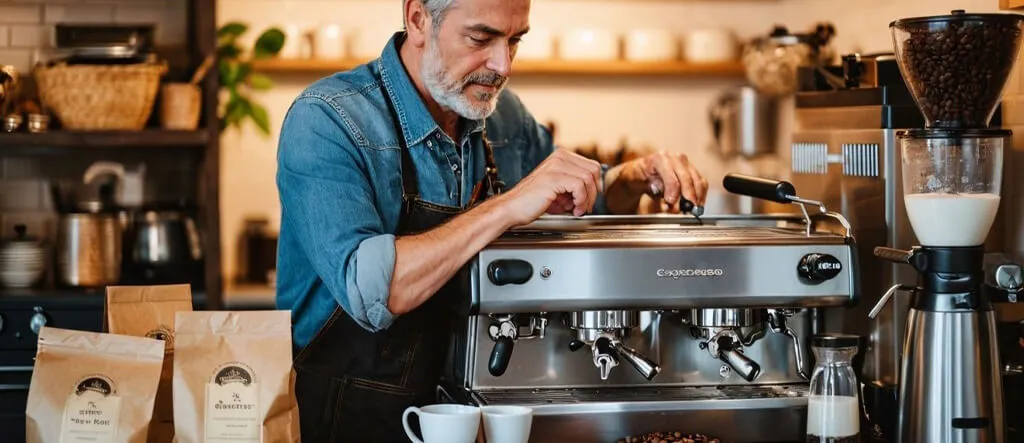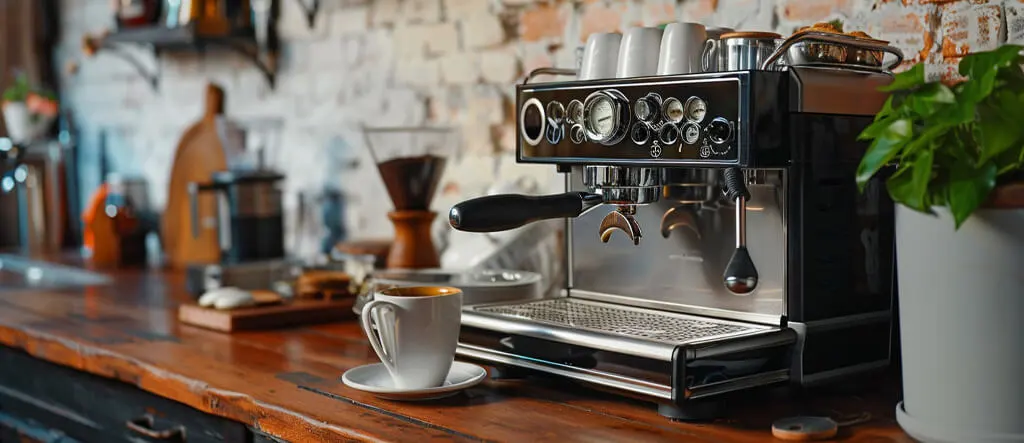Having trouble replicating that perfect espresso shot from your coffee spot in the comfort of your home? Achieving the flavor, texture, and temperature can feel like a major task if you’re unfamiliar with how your espresso machine operates.
Espresso machines may be intricate. Grasping their workings can significantly enhance your coffee-making abilities.
An essential aspect of espresso machines is their utilization of pressure to push water through finely ground coffee beans, resulting in the concentrated drink we know as espresso. This article will walk you through each component of an espresso machine and elucidate how these parts collaborate to prepare your morning pick-me-up.
You’ll understand the workings of these devices and discover how to apply this knowledge to achieve superior brewing outcomes.
Continue reading for expert advice on crafting the cup of espresso every time.
What is Espresso, and How is it Made?
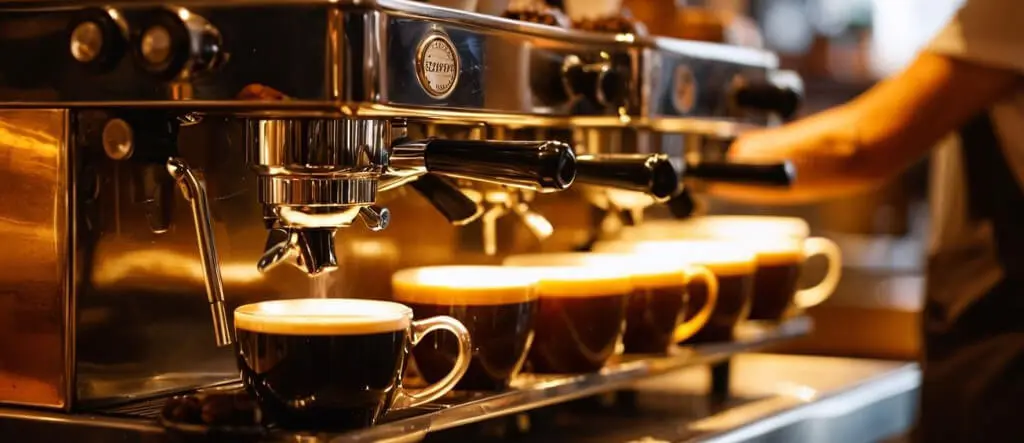
Espresso, a coffee variant, originated in Italy in the late 1800s. It is distinguished by its hue and thick texture, topped with a creamy foam called crema.
An espresso machine pushes hot water through packed finely ground coffee beans using steam, pistons, or pumps to create espresso. This process extracts the intense flavors and oils from the beans to produce a robust shot of coffee.
Ideally, this process should last around 25 seconds to yield 1.5 ounces of espresso. Unlike coffee and espresso blends, bean types from different countries are roasted until dark and oily.
Exploring how this strong brew is crafted sheds light on the engineering behind each espresso machine.
The Main Parts of an Espresso Machine
An espresso maker comprises elements to transform coffee into the flavorful and fragrant beverage that we enjoy. Each component has a function: to prepare a flawless serving of espresso that operates harmoniously in unison.
The Water Source
The water source in an espresso machine is essential for brewing a cup of espresso. In-home espresso machines, water is typically sourced from a reservoir that users manually fill or directly connect to the home’s water supply, ensuring a water flow.
Each option has its advantages, balancing convenience with the ability to control the quality of water used for coffee.
Deciding between a reservoir and a direct connection depends on preference and kitchen layout. Machines with built-in reservoirs offer flexibility and simplicity as they don’t require installation.
On the other hand, pump-driven espresso machines with connections provide consistency by drawing water directly from the home’s supply line. This minimizes the need for refills and ensures water quality, which is crucial for extracting the full flavor from coffee beans.
The Pump
The pump is an element in espresso machines that utilizes either a vibratory pump or a rotary vane pump to move water and create pressure. This part pulls water from its source and pushes it through packed coffee at an impressive 135 PSI, ensuring that each espresso is brewed perfectly.
Companies like La Pavoni, with a long history, rely on advanced engineering to integrate these pumps effectively into their machines.
Many models have temperature control technologies, such as PID controllers or digital temperature controls. These advancements enable adjustments to the pump’s performance, ensuring water temperature throughout the brewing process.
Whether selecting a vibratory or rotary vane pump, customers can use its effectiveness to consistently produce top-notch espresso shots.
Enthusiasts of espresso machines admire La Marzocco’s commitment to excellence and innovation.
Having recognized the pump’s importance in preparing espresso, the focus now shifts to another component: the boiler.
The Boiler
When we move away from the pump, which helps extract espresso by creating pressure, our attention shifts to the boiler. This part heats water and produces steam in an espresso machine.
While most machines have a boiler controlled by two thermostats to manage brewing and steaming temperatures, higher-end models offer boilers or heat exchangers for more advanced functionality.
Dual boiler systems allow for brewing coffee and steaming milk simultaneously, improving efficiency during operation. Hand heat exchanger setups use a design that swiftly heats water to the ideal temperature for brewing without any delays between tasks.
For efficiency, thermoblock models utilize separate brew boilers to rapidly heat water as needed, ensuring quick and consistent steam production. This is useful for frothing milk or preparing tea alongside espresso shots.
Portafilter and filter basket
The portafilter is a removable part of an espresso machine that securely holds ground beans while brewing. Inside it, you’ll discover the filter basket, which acts as a vessel for your coffee grounds.
During this stage, something special occurs – the enticing coffee oils seep out. Blend with water under high pressure to produce a shot of richly flavorful espresso.
Achieving the extraction isn’t about using top-quality beans or getting the grind just right; understanding how these elements work harmoniously is also essential. Various types of portafilters are available in the market, each with its specifications and unique features allowing users to tailor their brews to suit their preferences.
Proper cleaning and maintenance of both the portafilter and filter basket are vital to ensuring they continue delivering top-notch shots of coffee time after time.
The Steam Wand
After talking about the boiler, which warms up the water for the espresso machine, the next important part is the steam wand. This key tool for baristas froths milk to make perfect smooth foam for cappuccinos and lattes.
The steam wand releases steam from one of the machine’s boilers through a tube into your milk pitcher.
Also referred to as a milk frother or steaming wand, this component of your espresso or latte maker is activated by turning a knob or lever connected to the steam valve. By injecting steam into the milk. Aerates it, producing foam that enhances any espresso-based beverage.
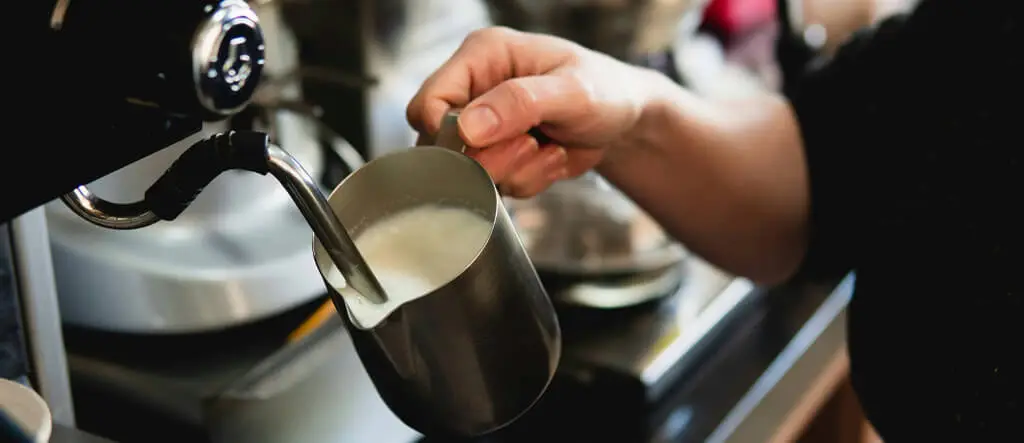
The Group Head
The group head in an espresso machine plays a role as it holds the portafilter and guides water through the coffee grounds, ensuring a consistent water temperature and uniform flavor in each espresso shot.
It contains parts. It is available in various types, each tailored to enhance brewing.
The group head stands out as an element in creating an espresso brew.
The quality of an espresso largely relies on the performance of the group head. The group head ensures that every extraction meets taste and quality standards by regulating the water temperature while it flows through ground coffee.
With its design and functionality, the group head contributes to the interplay of pressure, heat, and timing that characterizes espresso brewing.
The Inner Workings of an Espresso Machine
Unveiling the workings of an espresso machine reveals the enchantment that goes into crafting every flawless cup of coffee. In these devices, pressure and heat work harmoniously to convert water and finely ground coffee beans into a flavorful espresso shot.
How Pressure is Used to Brew Espresso
Many espresso machines use a pump to create water pressure of about 135 PSI, pushing water through packed coffee grounds. This method of brewing at pressure is important as it extracts the oils from the coffee resulting in the strong and creamy taste that defines espresso.
Innovations like those in La Marzocco machines have improved this process by introducing speed gear pumps. These pumps allow baristas to adjust the pressure during brewing to extract flavors.
A lower water-to-coffee ratio is maintained by controlling the water pressure, which is crucial for achieving espresso’s consistency. With these advancements in machine technology, including features that regulate brewing pressure, users can consistently enjoy high-quality shots each time they make their coffee.
This approach underscores the importance of understanding and managing pressure when crafting an espresso cup.
The Role of Heat in the Process
Heating is crucial when making espresso, as temperature control is required to bring out the best flavor. The recommended water temperature for extracting espresso is between 93 and 100 degrees Celsius.
Espresso machines utilize pressure stats, digital temperature controls, and integral derivative (PID) controllers to ensure the boilers reach this optimal range.
This accuracy guarantees that every cup of coffee captures the taste and aroma sought by baristas and coffee enthusiasts.
Over time, espresso machines have become more energy efficient while maintaining temperature regulation. Some modern models feature boiler systems with boilers for steaming milk and brewing water.
This setup enhances efficiency and consistency during extraction by keeping temperatures throughout the process. Ongoing innovations focus on reducing energy consumption in these machines without compromising the performance or quality of the extracted espresso shot.
Now, let’s delve into why the portafilter is another element in creating a remarkable espresso.
The Importance of the Portafilter
The portafilter is a component of the espresso machine that serves as the container for the coffee grounds used for brewing. Its role goes beyond holding coffee; it ensures the grounds are evenly spread and properly compressed.
This consistency and pressure are vital in extracting oils from coffee beans, producing the espresso taste enthusiasts crave. A compressed coffee bed creates the required resistance during water passage, leading to a robust espresso.
Portafilters are available with either wall or single-wall baskets, offering users levels of control and accuracy in brewing. A 58 mm diameter portafilter is recommended to maintain temperature and even heat distribution throughout extraction.
Precise heat control guarantees that every cup of espresso retains its quality from the first sip to the last, underscoring why selecting the right portafilter basket is crucial for creating an espresso experience.
Tips & Tricks for Making the Perfect Espresso
Uncover the craftsmanship behind crafting an espresso with advice that elevates your expertise in brewing coffee.
Selecting the Right Coffee Beans
Choosing the coffee beans is crucial in creating an espresso. It’s best to go for beans roasted 1 2 weeks ago to ensure they are at their freshest and most flavorful. Different roast levels, such as light, medium, or dark, bring out characteristics and flavors in your espresso.
Opting for specialty coffee beans from artisanal coffee roasters of supermarket varieties guarantees higher quality.
By supporting specialty roasters, you get access to fresh beans and explore different methods of processing espresso beans that can impact the taste.
The key to brewing an espresso lies in your choice of bean. Its freshness, roast level, and processing all create a standout cup.
The Importance of Proper Grinding
Proper grinding is key to brewing espresso. Investing in a high-quality grinder is crucial, as it greatly impacts the taste of your espresso.
Using a top-notch grinder with an espresso machine can often result in better coffee than using a less reliable grinder with a high-end machine. This emphasizes how important it is to have a grind for making coffee.
The size and consistency of the grind directly impact espresso extraction, influencing its flavor, richness, and overall harmony. Inadequate or irregular grinding can disrupt this balance more than machine variations.
Therefore, honing your grinding skills is vital for any barista striving to achieve perfection in brewing. A consistent grind from your grinder ensures particle distribution and weight, setting the stage for each shot of espresso to meet standards.
Tamping the grounds
Tamping down the coffee grounds in the portafilter is a step in espresso-making. It involves packing the grounds tightly using a tamper to create water flow resistance, which helps regulate how the coffee brews.
Applying 20 to 30 pounds of pressure ensures that the water seeps through evenly, drawing out all those flavors from the beans. Tamping, along with factors like dose and grind size, plays a role in crafting a balanced and flavorful espresso shot.
It’s vital to find the amount of pressure when tamping to avoid channeling, which can disrupt how crema forms on top of your espresso. Remember, gentle but firm tamping leads to brewing outcomes.

Understanding Shot Times
Getting the timing right is crucial when brewing espresso. Aim for a brew time of around 35 seconds to achieve extraction using 18.5 grams of coffee grounds. This timeframe ensures that water flows through the packed grounds for the time needed to draw out delicious flavors without causing bitterness.
Studies have revealed that this combination strikes a balance, resulting in a liquid and foam weight of 45 grams, a common benchmark for achieving espresso excellence.
The precise adjustment of brewing factors has been honed over years of testing and refining espresso techniques. Adhering to these standards guarantees an espresso experience each time you operate your machine.
Mastery of shot timing goes beyond hitting numbers; it involves grasping how every detail, from grind size to tamping pressure, influences the result. This ultimately leads to mastering the art of steaming milk properly.
Proper Milk Steaming Techniques
When making espresso drinks, it’s not about timing your shots right – mastering the art of steaming milk is also key. Steaming milk involves heating it and adding air to give your lattes and cappuccinos that texture we all love.
For a foam that holds up well, go for skim milk. Opt for milk if you prefer a richer taste. To get that perfect microfoam needed for latte art, position the steam wand below the surface of the milk.
To achieve sweetness and body in your drinks, incorporate air into the milk using steam wand until it reaches a certain temperature. Swirl the pitcher as you steam to ensure heat distribution and avoid scalding for a process.
By following these steps, you’ll be able to top off your creations with froth that adds a delightful touch to every sip.
Different Types of Espresso Machines
There are kinds of espresso machines on the market, such as lever machines, semi-automatic machines, automatic machines, and super-automatic machines.
Manual lever machines
Lever-operated espresso machines stand out as a type of coffee maker that requires hands-on involvement from the user. These machines feature a design and function using a lever system.
When using lever machines, you are responsible for grinding and tamping the coffee beans and then utilizing the lever to regulate the water flow. This process tests your barista skills as you manually adjust the pressure to extract that shot of espresso.
Manual lever machines hearken back to the days of machine engineering. Their use of pistons and levers evokes a nostalgic charm that coffee aficionados truly appreciate.
Semi-automatic machines
Semi-automatic espresso machines are quite popular among those who enjoy making coffee at home. These machines give you the freedom to oversee the brewing process. You’ll need to grind your coffee beans, pack them into the portafilter, and then just push a button to extract the espresso.
It’s a choice if you like being hands-on throughout the coffee-making journey. Whether you’re just starting to explore espresso or are already deeply passionate about coffee, semi-automatic machines provide a satisfying brewing experience without complexity.
Automatic machines
Using espresso machines is a choice for those seeking a hassle-free way to enjoy their favorite coffee. These machines handle most tasks, from grinding the beans to brewing a shot.
With machines, there’s no need to worry about tasks like tamping or pulling shots. Simply push a button and watch as the machine works its magic. Some models even have settings that allow you to tailor your drink to suit your preferences.
Brands such as Eversys are renowned for their notch automatic machines that consistently produce excellent results. If you’re in the market for an espresso maker that does it all, an automatic machine is worth considering.
Super-automatic machines
Super-automatic espresso machines represent the pinnacle of convenience and advancement in coffee brewing. These elegant devices handle every aspect of the process, from grinding beans to transferring the grounds into a brewing unit.
With a button press, you can savor coffee that rivals what a skilled barista would craft without any unnecessary complications. Moreover, certain super-automatic machines are equipped with hoppers and grinders, offering choices between coffee and decaf.
As technology progresses, these machines continue to develop features and capabilities, making them a favored option for coffee enthusiasts seeking both ease and excellence in their caffeine fix.
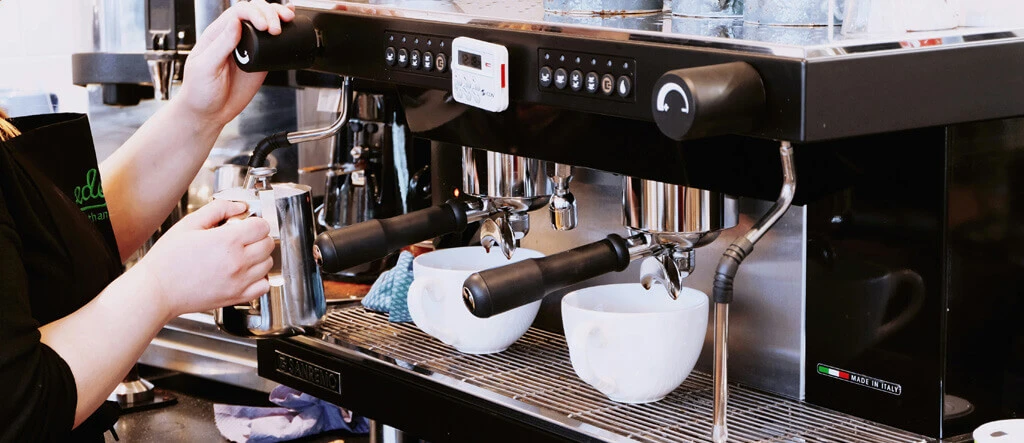
Wrapping Up
Espresso makers work their magic by blending water and coffee grounds to create an espresso. Exerting 9 bars of pressure, they skillfully draw out the essence of coffee.
Each component, from the water supply to the steaming wand, contributes significantly to the brewing process. With advice on selecting beans and refining your grinding technique, achieving café quality espresso at home is within reach.
Why not experiment with espresso-based beverages armed with this information? Let this serve as your roadmap to mastering home espresso brewing.
FAQs
Catchy Title:
1. “Unveiling the Hidden Secrets of Espresso Machines – Prepare to be Amazed!”
2. “You Won’t Believe How Espresso Machines Brew the Perfect Cup of Joe – Jaw-Dropping Discoveries Inside!”
3. “The Ultimate Guide: Demystifying Espresso Machines and Revealing Their Magical Brewing Powers”
4. “From Coffee Beans to Heavenly Espressos: The Mind-Blowing Science Behind Espresso Machine Technology”
5. “Warning: This Eye-Opening Exposé Will Forever Change How You See Your Favorite Espresso Machine”
Meta Description:
1. Uncover the secrets of your morning pick-me-up as we delve into the inner workings of espresso machines. Get ready for a jolt of coffee knowledge!
2. Discover the fascinating world behind your favorite cup of joe with a closer look at how espresso machines work. Your caffeine fix just got more interesting.
3. Curious about how that perfect shot of espresso is crafted? Dive into our guide on the mechanics behind espresso machines and become a coffee connoisseur in no time!

